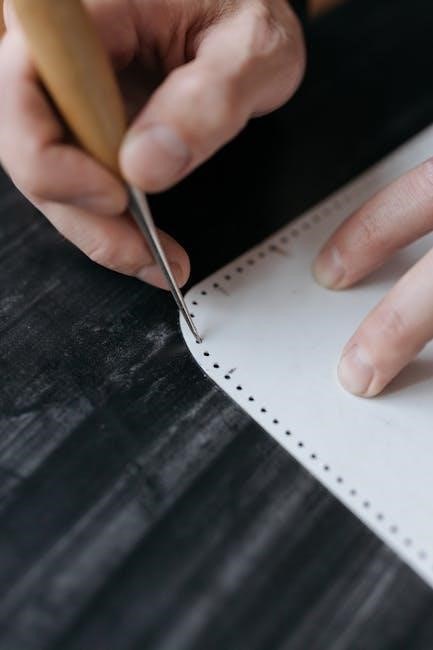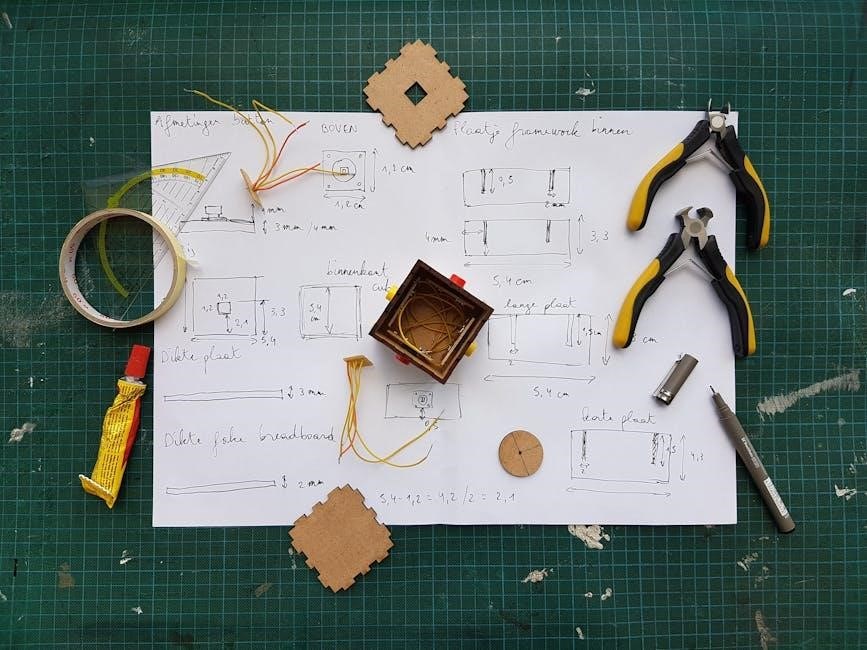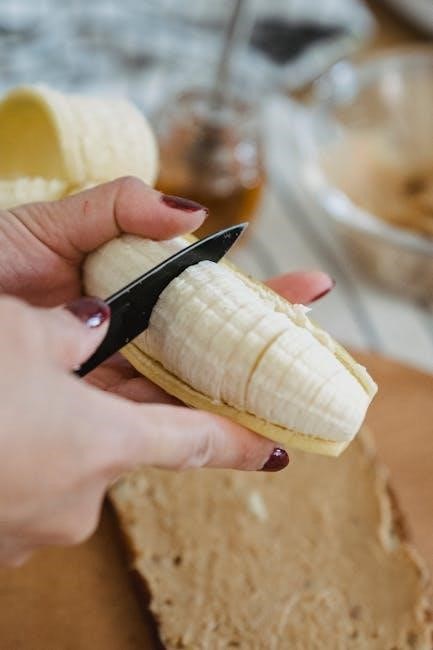Welcome to the Panasonic Bread Maker Manual! This guide helps you master your bread maker, covering models like SD-P104 and SD-2500. Discover features, recipes, and troubleshooting tips for perfect bread-making experiences.
1.1 Overview of the Panasonic Bread Maker
The Panasonic Bread Maker is a versatile kitchen appliance designed for automatic bread-making. Models like the SD-P104 and SD-2500 offer advanced features, including multiple modes such as Basic, Rapid, Dough, and Gluten-Free. These machines are equipped with a bread pan, kneading blade, and yeast dispenser for precise dough preparation. Additional functionalities like nut and raisin dispensers enhance customization. The user-friendly interface and preset options make it easy to create a variety of bread types, from classic white bread to specialty loaves. With its compact design and efficient operation, the Panasonic Bread Maker is a practical addition to any home bakery.
1.2 Importance of Reading the Manual
Reading the Panasonic Bread Maker manual is essential for optimal performance and safety. It provides detailed instructions for setup, operation, and maintenance, ensuring you understand all features and modes. The manual outlines safety guidelines, proper ingredient measurements, and troubleshooting tips, helping you avoid common errors. Additionally, it includes warranty information and care instructions to extend the product’s lifespan. By following the manual, you can explore advanced functions like gluten-free modes and specialty settings, unlocking the full potential of your bread maker. This guide is your key to achieving perfect results and enjoying a seamless bread-making experience.

Safety Precautions
Always unplug the machine before cleaning and avoid touching hot surfaces. Properly insert the bread pan and ensure the start light is off. Follow guidelines to prevent accidents.
2.1 General Safety Guidelines
Always read the manual carefully before using your Panasonic Bread Maker. Ensure proper usage to avoid accidents. Never insert metal objects or fingers into the machine. Keep children away while operating. Avoid touching hot surfaces during operation. Place the machine on a stable, heat-resistant surface. Prevent overheating by ensuring good ventilation. Never leave the machine unattended during operation. Handle the bread pan and kneading blade with care to avoid injury. Unplug the machine before cleaning or maintaining it. Follow all safety instructions to ensure safe and efficient bread-making experiences.
2.2 Electrical Safety Tips
Ensure the Panasonic Bread Maker is used on a stable, dry surface away from water. Avoid exposing the machine to direct sunlight or moisture. Use the appliance with the provided power cord and plug it into a grounded outlet. Never overload electrical outlets or use damaged cords. Keep the power cord away from hot surfaces or sharp objects. Avoid touching electrical parts with wet hands. Do not operate the machine near flammable materials. Always unplug the machine before cleaning or maintenance. Follow these tips to ensure safe and reliable operation of your Panasonic Bread Maker.
2;3 Handling Precautions
Always handle the Panasonic Bread Maker with care to avoid accidental damage or injury. Use oven mitts or a towel when removing hot bread pans or touching exterior surfaces. Keep children away from the machine while it is operating. Avoid sudden movements that could tip the machine. Never insert metal objects or utensils into the bread pan or machine openings. Clean the machine only when it is unplugged. Avoid using abrasive cleaners that could damage the finish. Regularly inspect the power cord and plug for damage. Proper handling ensures safe and efficient use of your Panasonic Bread Maker.

Accessories and Parts Identification
Identify your Panasonic Bread Maker’s accessories, including the bread pan, kneading blade, and additional components like measuring cups. Familiarize yourself with each part for optimal use.
3.1 Main Unit Components
The main unit of your Panasonic Bread Maker includes the control panel, display screen, and buttons for selecting modes. It also features a steam vent, yeast dispenser, and power cord. The control panel allows you to choose settings like Basic, Rapid, or Gluten-Free modes. The display screen shows the current mode and baking progress. Buttons enable easy navigation through settings, while the steam vent aids in even baking. The yeast dispenser ensures precise yeast release for optimal dough rise. These components work together to create a user-friendly experience for perfect bread-making results every time.
3.2 Bread Pan and Kneading Blade
The bread pan is the heart of your Panasonic Bread Maker, designed to hold ingredients and shape the dough. It is removable for easy cleaning and features a non-stick coating to prevent bread from sticking. The kneading blade, located inside the pan, mixes and kneads the dough evenly. Ensure the pan is properly seated in the main unit before operation. Regularly clean the pan and blade to maintain hygiene. For optimal results, avoid using abrasive cleaners, as they may damage the non-stick surface. Proper care extends the lifespan of these essential components, ensuring consistent bread quality.
3.4 Additional Accessories
Your Panasonic Bread Maker comes with additional accessories to enhance your bread-making experience. These include a measuring cup and spoon for precise ingredient measurements, ensuring accurate dough preparation. A recipe book is also provided, offering a variety of bread and dough recipes to explore. Some models may include a raisin and nut dispenser for adding mix-ins automatically. These accessories are designed to simplify the process and expand your creative possibilities. Always use the provided measuring tools for consistency, and refer to the recipe book for inspiration and guidance. Proper use of these accessories ensures the best results from your bread maker.

How to Use the Bread Maker
Start by setting up the machine, selecting the desired mode, and adding ingredients. Follow the instructions for operating the bread maker to achieve perfect results every time.
4.1 Initial Setup and Preparation
Before first use, unpack and place the bread maker on a stable, heat-resistant surface. Ensure the bread pan is securely inserted into the main unit. Plug in the machine, ensuring the power cord is safely positioned. Familiarize yourself with the control panel and settings. For initial setup, select the dough type and crust color preference. Ensure the kneading blade is properly attached to the bread pan. always check that the start light is off before adding ingredients. Refer to the manual for specific model instructions, such as those for the SD-P104 or SD-2500, to ensure proper preparation and safety.
4.2 Selecting the Right Mode
Selecting the right mode ensures your bread turns out perfectly. Panasonic bread makers offer various modes, including Basic, Rapid, Dough, Gluten-Free, and Specialty. Choose Basic for classic bread, Rapid for quicker baking, or Dough for preparation without baking. Gluten-Free mode adjusts for special dietary needs, while Specialty allows customization. Always match the mode to your recipe and desired outcome. Use the control panel to select your preferred option, and adjust settings like crust color if available. Ensure the mode aligns with the ingredients and baking time for optimal results. Refer to your specific model’s manual for detailed mode descriptions and guidance.
4.3 Adding Ingredients
Adding ingredients correctly is crucial for perfect bread. Place the bread pan into the main unit and ensure it is secure; Add dry ingredients like flour, yeast, and salt first, followed by wet ingredients such as water, milk, or butter. Use the yeast dispenser if available for precise distribution. For models with raisin or nut dispensers, add these ingredients separately to ensure even mixing. Always follow the recipe’s measurements and order to avoid overmixing or uneven distribution. Refer to your Panasonic bread maker’s manual for specific guidelines, as some models may have unique features or requirements for ingredient placement.
4.4 Operating the Machine
Once ingredients are added, plug in the machine and select the desired mode. Choose options like Basic Bread, Rapid, or Gluten-Free. Set crust color preference and loaf size. Press Start to begin the cycle. The machine handles mixing, kneading, rising, and baking. Avoid opening the lid during operation to maintain consistent temperature. Use the delay timer for convenient baking schedules. After completion, let the bread cool before slicing. Regularly clean the bread pan and kneading blade for optimal performance. Experiment with different settings and recipes to achieve your perfect loaf.

Understanding Different Modes and Settings
Explore the diverse modes: Basic for classic bread, Rapid for quick results, Dough for manual finishing, Gluten-Free for special diets, and Specialty for custom creations. Each mode offers unique settings to tailor your bread-making experience, ensuring perfect results every time. Adjust crust color, loaf size, and yeast preferences to suit your recipe. This versatility allows you to craft a wide variety of breads effortlessly, from traditional loaves to innovative specialties.
5.1 Basic Bread Mode
The Basic Bread Mode is ideal for traditional bread recipes, offering a straightforward and reliable way to bake classic loaves. This mode automatically handles mixing, kneading, rising, and baking, ensuring consistent results. It supports various crust color options—light, medium, or dark—and accommodates different loaf sizes, from small to large. Perfect for everyday use, the Basic Mode is compatible with both instant dry yeast and active dry yeast, providing flexibility for your recipes. Its simplicity makes it a great starting point for beginners, while experienced bakers can still appreciate its dependable performance. This mode is also 100% gluten-free compatible, catering to special dietary needs.
5.2 Rapid Mode
Rapid Mode is designed for time-conscious users, enabling faster bread making while maintaining quality. This mode reduces the overall baking time by optimizing the rising process, allowing you to enjoy freshly baked bread sooner. It works well with both basic and specialty recipes, including gluten-free options. The Rapid Mode ensures even cooking and a golden crust, with adjustable crust color settings. Perfect for busy schedules, it delivers consistent results without compromising flavor. For the best experience, use instant dry yeast, as it activates quickly, aligning with the accelerated cycle. This mode is a convenient solution for those seeking efficiency without sacrificing taste or texture.
5.3 Dough Mode
Dough Mode is perfect for preparing homemade pasta, pizza, or bread rolls without baking. This setting mixes, kneads, and proofs the dough to perfection, ready for shaping. Use high-quality flour and adequate water for optimal results. The mode ensures even gluten development, creating smooth, elastic dough. After completion, remove the dough and shape it as desired. For best results, avoid overloading the pan and ensure the bread pan is properly aligned. Clean the machine immediately after use to prevent dough residue buildup. This mode is ideal for those who enjoy handcrafted breads and pastries, offering flexibility and convenience.
5.4 Gluten-Free Mode
Gluten-Free Mode is designed for individuals with dietary restrictions, offering a dedicated setting for baking gluten-free bread. This mode ensures proper mixing, kneading, and proofing to achieve the best texture. Use high-quality gluten-free flour and adequate liquid for optimal results. The machine adjusts the cycle to prevent over-proofing, a common issue with gluten-free dough. Follow the manual’s guidelines for precise ingredient ratios and baking times. This mode allows you to enjoy fresh, homemade gluten-free bread with ease, catering to specific dietary needs while maintaining flavor and quality. Always clean the machine thoroughly after use to avoid cross-contamination.
5.5 Specialty Mode
Specialty Mode offers advanced customization for unique bread recipes, such as jam, compote, or specialty dough. This mode provides precise temperature and time controls, ensuring optimal results for specific ingredients. It allows users to create diverse bread types with tailored settings, enhancing flexibility and creativity. Perfect for experimenting with flavors or recipes, Specialty Mode caters to those who enjoy variety in their bread-making. Always refer to the manual for specific guidelines on ingredient ratios and cycling times to achieve the best outcomes. This feature makes your Panasonic Bread Maker versatile and adaptable to various culinary preferences.

Recipes for Panasonic Bread Maker
Discover delicious recipes tailored for your Panasonic Bread Maker, including basic white bread, whole wheat, and gluten-free options. Explore diverse flavors and baking tips for perfect results.
6.1 Basic White Bread Recipe
Start with simplicity using the Basic White Bread Recipe. Add 2 cups of bread flour, 1 teaspoon of salt, 1 tablespoon of sugar, and 1 packet of instant yeast. Pour in 1 cup of warm water. Select the Basic Bread mode on your Panasonic Bread Maker. Let the machine knead, rise, and bake to perfection. In about 2-3 hours, enjoy a soft, fluffy loaf. For a golden crust, ensure the bread cools on a wire rack. This recipe is a perfect foundation for experimenting with additional flavors and ingredients later. Perfect for beginners and everyday use!
6.2 Whole Wheat Bread Recipe
Create a hearty and nutritious loaf with the Whole Wheat Bread Recipe. Combine 2 cups of whole wheat flour, 1/2 cup of bread flour, 1 teaspoon of salt, 1 tablespoon of sugar, and 1 packet of instant yeast. Add 1 cup of warm water and 1 tablespoon of olive oil. Choose the Whole Wheat or Basic Bread mode on your Panasonic Bread Maker. The machine will handle the kneading, rising, and baking process. For a denser texture, use 100% whole wheat flour. Let the bread cool before slicing for the best results. Perfect for a healthier, homemade option!
6.3 Gluten-Free Bread Recipe
Enjoy a delicious gluten-free loaf using your Panasonic Bread Maker. Combine 2 cups of gluten-free flour, 1 teaspoon of xanthan gum, 1 teaspoon of salt, 1 tablespoon of sugar, and 1 packet of gluten-free yeast. Add 1 cup of warm water, 1 tablespoon of olive oil, and 1 tablespoon of apple cider vinegar. Select the Gluten-Free mode on your Panasonic Bread Maker. The machine will expertly mix, knead, and bake the dough. For optimal texture, ensure all ingredients are at room temperature; Let the bread cool completely before slicing for the best results. Perfect for those with dietary restrictions!

Customizing Your Bread
Personalize your bread with Panasonic’s versatile settings. Adjust crust color for a lighter or darker finish and explore various modes like Gluten-Free and Specialty for unique flavors. Add nuts, raisins, or herbs for texture and taste, enhancing your creations effortlessly with each use.
7.1 Adjusting Crust Color

Customize your bread’s crust color with ease using Panasonic’s adjustable crust control. Choose from light, medium, or dark settings to achieve your preferred texture and appearance. For lighter crusts, select the light mode, while darker settings are ideal for a crispy finish. This feature ensures your bread meets your personal preference every time. Simply refer to your Panasonic bread maker manual for specific model instructions, such as the SD-P104 or SD-2500, to adjust the crust color setting before starting the baking cycle. This customization option enhances your bread-making experience, allowing you to tailor results to your taste.
7.2 Adding Yeast and Salt
Properly adding yeast and salt is essential for optimal bread quality. Use instant dry yeast for best results, as it dissolves quickly and ensures even fermentation. Add yeast directly to the bread pan, following the manual’s guidelines for your Panasonic model. Salt enhances flavor and texture but should be added separately to avoid deactivating the yeast. For models like the SD-P104 or SD-2500, place yeast in the yeast dispenser if available. Always measure ingredients accurately and adjust based on recipes. Refer to your Panasonic bread maker manual for specific settings that may affect yeast activation, such as rapid bake modes.
7.3 Incorporating Nuts and Raisins
Incorporating nuts and raisins into your bread is easy with your Panasonic bread maker. For models like the SD-P104 or SD-2500, use the raisin nut dispenser to ensure even distribution. Add nuts or raisins during the initial ingredient setup or when prompted by the machine. Toasting nuts lightly before adding enhances flavor. Use the basic or specialty modes for optimal results. Avoid overloading the dispenser to prevent jamming. For machines without a dispenser, add ingredients manually during the dough cycle. This feature allows you to create delicious variations like raisin bread or nutty whole wheat effortlessly.

Troubleshooting Common Issues
Address common issues like bread not baking properly or the machine not turning on. Check power connections, ensure correct mode selection, and verify ingredient measurements for optimal results.
8.1 Bread Not Baking Properly
If your bread isn’t baking properly, check the power connection and ensure the machine is turned on. Verify the start light is off before selecting a mode. Ensure yeast is fresh and added correctly. Measure ingredients accurately, as over- or under-filling can affect results. Check the bread pan for proper placement and ensure the kneading blade is secure. If using delayed start, confirm the timer is set correctly. For models with a yeast dispenser, ensure it’s not clogged. Refer to troubleshooting guides in your manual for specific error codes or unusual behaviors, and adjust settings as needed for optimal baking performance.
8.2 Machine Not Turning On
If the machine fails to turn on, first ensure it is properly plugged into a working electrical outlet. Check the power cord for any damage or loose connections. Verify that the outlet is functioning by testing it with another appliance. Ensure the machine’s power button is pressed firmly and the display lights up. If issues persist, check your home’s circuit breaker or fuse box to ensure no interruptions. Consult the user manual or contact Panasonic support for further assistance if the problem continues unresolved.
8.4 Unpleasant Odors
Unpleasant odors in your Panasonic bread maker can occur due to leftover dough residue or improper cleaning. Regularly clean the bread pan, kneading blade, and interior with a damp cloth. For stubborn smells, mix equal parts water and white vinegar in the pan and run a short cycle. Ensure the machine is dry after cleaning to prevent mold. Avoid strong-smelling ingredients without proper ventilation. If odors persist, check for blockages in the steam vent or yeast dispenser. Refer to the manual for deep cleaning instructions to maintain freshness and hygiene.

Cleaning and Maintenance
Regularly clean the bread pan, kneading blade, and exterior with a damp cloth. Dry thoroughly to prevent rust and mold. Refer to the manual for deep cleaning instructions to ensure optimal performance and hygiene.
9.1 Cleaning the Bread Pan
Always unplug the bread maker before cleaning to ensure safety.
Remove the bread pan from the machine and gently wipe it with a soft sponge or cloth to avoid scratching the non-stick surface.
For tough spots, soak the pan in warm water for about 30 minutes to loosen any stuck-on dough or bread residue.
Avoid using harsh chemicals or abrasive scrubbers, as they may damage the non-stick coating.
After cleaning, dry the pan thoroughly with a clean towel to prevent water spots and mineral deposits.
Do not place the bread pan in the dishwasher, as high heat can damage the finish.
Regular cleaning will maintain the pan’s condition and ensure optimal performance for your bread maker.
9.2 Maintaining the Kneading Blade
Proper maintenance of the kneading blade ensures efficient dough mixing and longevity of your Panasonic bread maker. After each use, remove the blade from the bread pan and rinse it with warm water to eliminate any dough residue. For stubborn bits, soak the blade in warm water for 10-15 minutes before cleaning with a soft brush or cloth. Avoid using harsh chemicals or abrasive cleaners, as they may damage the blade’s surface. Dry the blade thoroughly after cleaning to prevent rust. Regularly inspect the blade for wear and tear, and replace it if it becomes bent or corroded. This ensures optimal performance for every loaf.
9.3 Wipe Down the Exterior
Regularly wiping down the exterior of your Panasonic bread maker is essential for maintaining its appearance and hygiene. Use a soft, damp cloth to gently clean the outer surfaces, paying attention to areas around buttons and vents. Avoid using harsh chemicals, abrasive cleaners, or excessive water, as they may damage the finish or seep into internal components. For stubborn stains or splatters, mix a small amount of mild detergent with warm water, dip a cloth, and wipe carefully. Dry the exterior thoroughly with a clean cloth to prevent water spots. Regular cleaning prevents crumbs and spills from building up and ensures your bread maker remains in top condition. This simple maintenance step also helps preserve the machine’s longevity and keeps it looking like new.
Master your Panasonic bread maker by exploring its modes, recipes, and maintenance tips. Enjoy experimenting with ingredients and settings to create delicious, customized bread effortlessly at home.
10.1 Final Tips for Optimal Use
To maximize your Panasonic bread maker’s performance, experiment with various modes like Gluten-Free and Specialty for diverse recipes. Regularly clean and maintain the machine for longevity. For enhanced flavor, add nuts or raisins during the kneading phase. Always measure ingredients accurately and adjust settings based on dough type. Refer to the manual for troubleshooting common issues. Explore the included recipes and customize them to your taste. Follow safety guidelines to ensure safe operation. By adhering to these tips, you’ll enjoy perfect homemade bread every time, tailored to your preferences and dietary needs.

